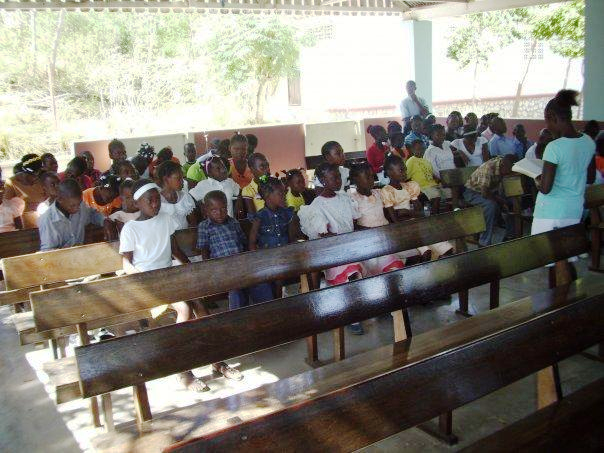
ON A SUNDAY MORNING three weeks after the earthquake which levelled so much of Haiti, cameraman John Tuk and I found ourselves at the Village of Hope, standing in front of a group of approximately 40 Haitian children (pictured below), ready for their morning church service.
They were preparing to thank God for sparing them from the massive death toll. But before the service began they broke into a beautiful welcome song. As the pastor played the notes on his accordion, the kids stared and sang. John and I were speechless. When the song ended we thanked the curious kids, and then I went to the back of the church to start taking notes, and forced myself not to cry.

We’d been in Haiti for a week at that point, and the spontaneous song hit John and I both in the heart.
It’s the children I’ll remember most from almost two weeks of reporting in Haiti.
Of course the images of massive piles of rubble and debris will stay with me forever. But they’re lifeless. The children are alive and acting exactly how kids should be acting. Whether they were patiently standing in mud, behind a rope line waiting for their only meal of the day (left), or flying crude kites above their new tent homes, kids-being-kids despite the least child-friendly environment imaginable inspired me.
Of course I was there to tell the stories, to try and show our audience what was happening in Haiti and how people from the CHCH viewing area were helping in the recovery effort.

But one of the biggest challenges John and I faced was technology. The first six days of our trip were spent embedded aboard HMCS Halifax. And the BGAN satellite phone we were sent with just wasn’t working. We spent a couple of hours most days trouble shooting the thing.
On board a ship that never anchored, I would run the antenna around the stern watching the signal strength bar rise and fall. John was on the phone with tech support, finding out there really wasn’t much support they could give us.
********************
AFTER AN INCREDIBLE flight on the edge of a Sea King helicopter from Jacmel over to Port au Prince, where CNN’s ‘Haiti Bureau’ was set up inside the Le Plaza hotel, we hit pay dirt. As a CNN affiliate, we were able to buy time on their satellite to feed our stories back to Hamilton, where they could finally be broadcast (right).

Some people questioned why a local news reporter would even be in Haiti. I tell them we weren’t there to tell the stories CTV, CBC and CNN were telling. We were there to show our audience how people they may recognize or know were helping in the wake of one of the worst natural disasters ever. And the responses on my blog (nickdixon.ca), as well as e-mails to the station showed how much people appreciated seeing stories that otherwise weren’t and wouldn’t be told.
The biggest frustration as a reporter, and human being, was that we saw so many people every day in such desperate need of help. But I was comforted by something a soldier I met on board HMCS Halifax said to me on the journey to Haiti from a re-supply stop in Jamaica. As the soldiers, sailors and I were discussing the differences in our jobs once we arrived, he looked at me and said “it’s your job to show Canadians what is really happening on the other side of the world.”
It’s clear to me now Canadians were watching, and they showed how much we all care about Haiti. On a per capita basis Canadians contributed more to the relief efforts than any other country. And without journalists there telling the stories, regardless of the scope, I wonder whether we all would have been so generous.
CHCH anchor Nick Dixon spent a week in Haiti in February, filing news reports and gathering additional research for a two part “Hope for Haiti” documentary which aired on CHCH last month. You can see the documentary, more of Nick’s photos and other video on his blog www.nickdixon.ca.


